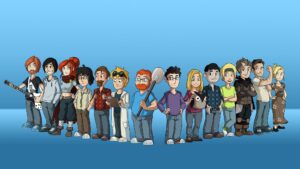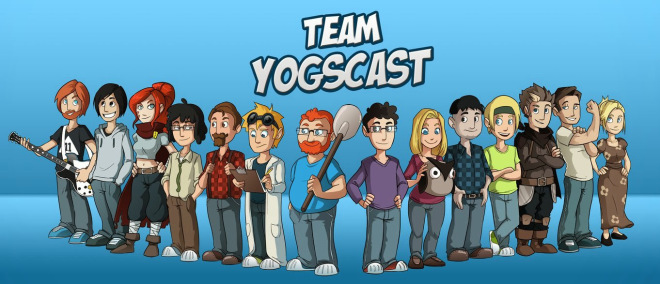The internet has changed the way users seek and consume information. Identifying how users are doing this is the key to providing better user experience for library patrons. I had the opportunity to interview a member of my information community and an avid gamer/ Minecraft enthusiast.
When interviewing an information seeking user from my community one thing was readily apparent. Their information seeking behavior was largely taking place online through various user-generated channels like YouTube and Reddit. Typically Minecraft users are playing the game when they encounter a problem that requires them to seek information. Often these are problems that are encountered by other users as well. The very nature of building and constructing in Minecraft translates well to video services like YouTube.
There has been an increasing shift in information consumption for gaming communities. Let’s Play videos are of particular value to gamers according to my interview source. This type of video is recorded by the author (the gamer) and showcases them playing through a particular game. Let’s Play videos are becoming more and more popular as the technology becomes more affordable since people can now produce video more easily. These are valuable because they allow the user to witness gaming experience through an experienced gamer. In Minecraft, Yogscast and Achievement Hunter are popular examples that my interviewee identified. Often these videos are mixed with humorous and entertaining commentary.

This gave me valuable insight into how users view the credibility and authority of the online content they are accessing. Typically, credibility can be assessed using things like frequency of publication (how often is new content being produced?), view count (how many times was this video viewed?) or number of likes the video has received (popularity according to the audience).
It was interesting to learn that my user did not put as much value in the comments section of videos. This is because the frequency of coming across a troll is quite high. A troll, according to Burnett (2000), is a user who posts a comment that is typically considered unpopular or untrue to create a ruse within other users or the community. In certain online communities comments are ranked higher on the comment board due to the number of responses, making comments from trolls the top comments.
I was also interested to learn that my interviewee was a content producer as well. Although they did not produce content frequently, they did when they thought something would be of value to the community. Flanagin, Hocevar & Samahito (2014) argued that the sense of community itself acts as an agent of authority for users. They state, “[W]hen people define themselves based upon a shared social group or category, they become ‘depersonalized’, perceiving increased instagroup similarities and acting based upon a shared identity and conception of self” (Flanagin, A.J., et al., p. 687). When people identify themselves with the community, they feel what they value will also be valued by other members of the community.
When asked about the role that libraries could play in the information seeking behavior of gaming users the interviewee was unsure. We spoke briefly about some books that were being produced about Minecraft gameplay (one example found here), but there was a concern about how up to date this information would be. Video games often receive regularly scheduled updates called patches, which often involve new content or changes to the way old content works (as seen in this infographic about the evolution of Minecraft). I think this is important to address. The landscape of gaming is changing. Video games are no longer static. As mentioned in the documentary Minecraft: A Story of Mojang, once a game is created today you can expect developers to patch, fix, and update content regularly, which often changes the entire game completely. Minecraft is even more complex because users can also modify (mod) the game (meaning create their own content for the game). A popular mod for Minecraft was called Technic. Technic was designed by users which allows them to create complex machinery in game that does not come with the base Minecraft experience. Users can download and play these mods, switch to new mods and revert to the original Minecraft game so quickly that published books cannot keep up with the evolution of the game. Web 2.0 allows for instant publication of materials within seconds of changes going live.
When asked what role the library could play in fostering a gaming community there was a very positive reaction. My interviewee thought the idea of bringing gaming to the library was an interesting idea. The collaborative potential of having people in the same room sharing ideas in person was something that interested them. The idea of the library as a space for collaboration is a key area worth exploring. Libraries need to evolve to stay relevant. In Aaron Schmidt’s guest lecture for week 7, he argues that by copying emerging trends libraries will always be one step behind, never ahead. By embracing new ways of thinking, libraries can evolve to meet the growing needs of its users and they can do this by identifying and learning who its users are. Instead of fighting change, libraries must embrace it. Schmidt (2015) argues that instead of shouting at its users, libraries must instead listen. This is the foundation to providing a good user experience.
Overall, my interview with my community member confirmed the foundational research that I have already conducted. The information seeking behavior of the Minecraft community is built largely upon Web 2.0’s connectivity and the ease and quickness to produce content. When users are the experts and the information they are seeking is so quickly changing, the content created is invaluable.
References:
Burnett, G. (2000). Information exchange in virtual communities: A typology. Information Research: An International Electronic Journal, 5, 82. Retrieved from http://www.informationr.net/ir/5-4/paper82.html
Flanagin, A. J., Hocevar, K. P., & Samahito, S. N. (2014). Connecting with the user-generated web: How group identification impacts online information sharing and evaluation. Information, Communication & Society, 17(6), 683-694. doi:10.1080/1369118X.2013.808361
Let’s Play (Video gaming). (n.d.). Retrieved from http://en.wikipedia.org/
Levering, P. (Producer), & Owens, P. (Director). (2012). Minecraft: the story of Mojang [motion picture]. USA: 2 Player Productions.
Schmidt, Aaron. [n.d.]. Aaron Schmidt User Experience Lecture [PDF document]. Retrieved from https://sjsu.instructure.com


I loved your write-up, and it gave me a starting point for what I wanted to research during my first semester at SJSU.
Hello Benjamin,
Thank you for sharing your thoughts. This is one of the best aspects of the MLIS program and the faculty at SJSU. Their openness and encouragement for students to pursue their own areas of interest make the program great. It’s quite funny how certain topics, like Minecraft, have a way of re-entering our lives. I found myself revisiting the game this past December after a lengthy hiatus. Moreover, it became a point of discussion once again at a recent conference I attended at the end of January. It’s fascinating how certain experiences can remain relevant and resurface in our professional conversations!
-Ryan